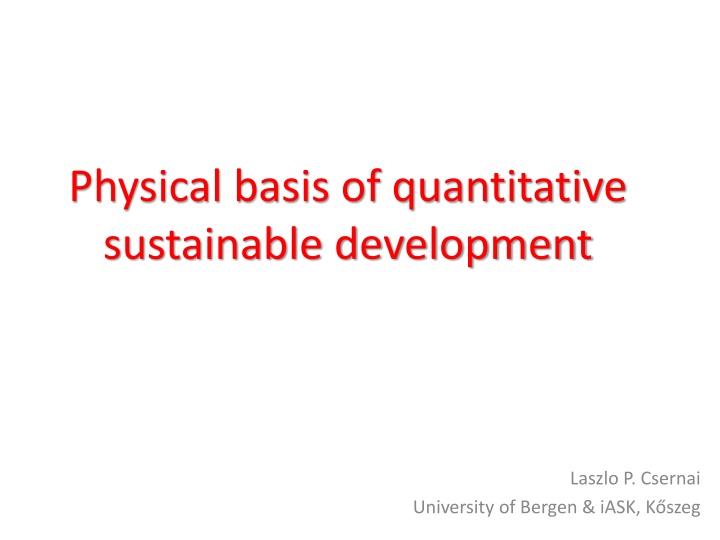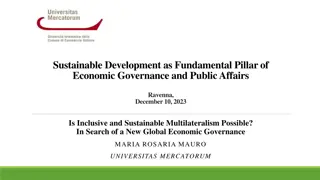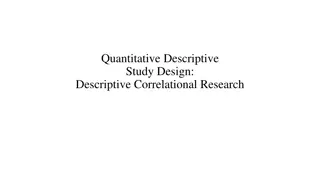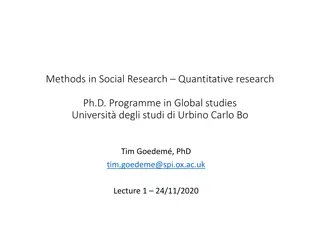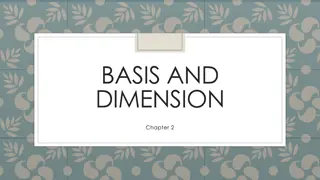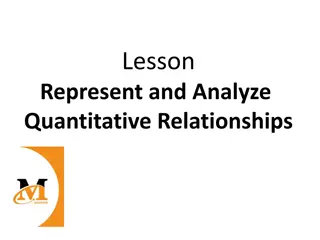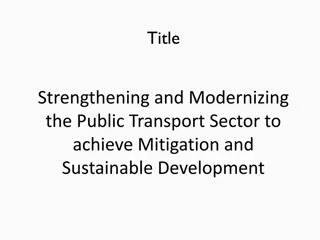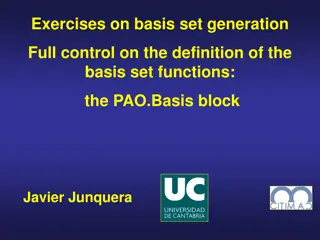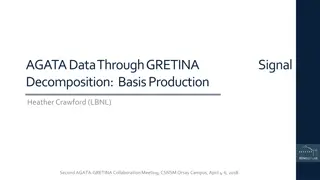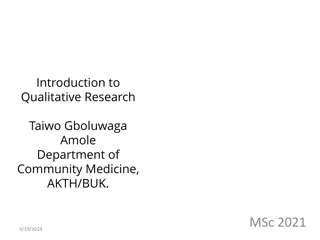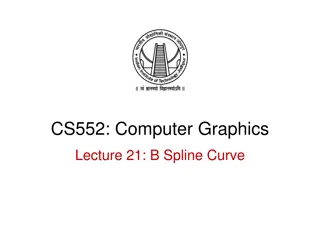Physical Basis of Quantitative Sustainable Development by Laszlo P. Csernai
This article explores the concept of sustainable development from a physical perspective, emphasizing the finite nature of Earth's resources and the intricate balance of energy supply and demand. It delves into the assessment of sustainability through quantitative measures, discussing the increasing complexity of development and the role of entropy as a key indicator. The Earth is depicted as an open system, where changes lead to evolving structures and systems over time. The relationship between energy, complexity, and development is analyzed through various works and research studies presented in the text.
Download Presentation

Please find below an Image/Link to download the presentation.
The content on the website is provided AS IS for your information and personal use only. It may not be sold, licensed, or shared on other websites without obtaining consent from the author.If you encounter any issues during the download, it is possible that the publisher has removed the file from their server.
You are allowed to download the files provided on this website for personal or commercial use, subject to the condition that they are used lawfully. All files are the property of their respective owners.
The content on the website is provided AS IS for your information and personal use only. It may not be sold, licensed, or shared on other websites without obtaining consent from the author.
E N D
Presentation Transcript
Physical basis of quantitative sustainable development Laszlo P. Csernai University of Bergen & iASK, K szeg
Based on recent works [1] L szl P l CSERNAI, Istv n PAPP, Susanne Fl SPINNANGR and Yi-Long XIE: Physical Basis of Sustainable Development, Journal of Central European Green Innovation 4 (2) pp. 39-50 (2016). [2] L.P. Csernai, S.F. Spinnangr, S. Velle: Quantitative assessment of increasing complexity, in preparation
Sustainable Development Our material resources are finite on the Earth The surface of the Earth is given and finite The energy supply to the Earth and from the Earth are approximately equal Still there is a clear and obvious development, which is sustained by now for many thousands or millions of years. How is it possible and how can this be assessed quantitatively ?
[Tamas Kocsis, ISES & Corvinus U., Koszeg 2015] http://www.ecoglobe.org/nz/sustain/popfosag.htm
The reality is different A given single resource may decrease, but it is replaced by a new source. This is even more visible per capita
The Earth is an open system In a closed system all changes Entropy increase: decreasing complexity, loose all structures, living species, plants, building, etc. only ashes and smoke would remain. - - The Earth is not a closed system, energy/ heat, dQin, is coming from the Sun, and as the Earth does not heat up too much (in the past many thousand years) about the same amount of heat is radiated out by the Earth, dQout dQin . - The change of the entropy of a system is: dS = dQ / T , so the change is dSEarth = dQin / TSun - dQout / TEarth << 0 , i.e. negative. 6000 K 300 K The Earth can develop, may become more complex\ planets? Water in 3 phases ~ constant T ~ complex molecules The lifetime of a developed Species: tlife S0 / dQmetab.
Sustainable development = Increasing complexity Can be measured by ENTROPY The Entropy as a concept of assessing development was introduced in the book: [3-ES] "What is Life? - The physical Aspect of the Living Cell by Erwin Schr dinger, Based on Lectures delivered under the auspices of the Institute at Trinity College, Dublin, in February 1943. [Cambridge University Press, 1944] [4] L. P nzes and L. Csernai: ber den Zusammenhang von Lebensdauer, Konstitution und Information, Z. Alternsforschung, 35/4, 285-296 (1980).
Order, Disorder and Entropy [3-ES] ORDER based on ORDER [3, s55] The laws of physics as we know them, are statistical laws. [Quantum mechanics] They have a lot to do with the natural tendency of things to go over to over into disorder." However, it is not always so, e.g. in quantum theory of low temperatures. "There are many instances of this." "Life seems to be orderly and lawful behavior of matter, not based exclusively on its tendency to go over from ORDER to DISORDER, but based partly on existing order that is kept up." ... , or even more so, there is a tendency to go over to MORE COMPLEX ORDER. "The living organism seems to be a macroscopic system, which ... approaches a purely mechanical conduct, ... and the molecular DISORDER is REMOVED."
Order, Disorder and Entropy [3-ES] LIVING MATTER EVADES the DECAY to EQUILIBRIUM[3, s56] "When a system that is not alive is isolated ..., the temperature becomes uniform [and a] permanent state is reached in which no observable events occur. The physicist calls this state of thermodynamical equilibrium, or of 'maximum entropy'." Reaching this equilibrium can be fast or later slow. "The ultimate slow approach to equilibrium could never be mistaken for life." [It is actually death.] As living matter is an open system S must not Smax
Order, Disorder and Entropy [3-ES] What is entropy? [3, s58] " ... it is not a hazy concept or idea, but a measurable physical quantity, just like length of a rod, the temperature at a point ..." etc. " At the absolute zero point (of temperature, -273 C) the entropy of any substance is zero. " the entropy is increasing by an amount, which is computed by dividing every little portion of heat [dQ] supplied, by the absolute temperature [T] at which it was supplied -- and summing up all these small contributions. The statistical meaning of entropy [3, s59] " ... important for us here is the bearing on the statistical concept of order and disorder, a connection that was revealed by the investigations of Boltzmann and Gibbs in statistical physics. This too is an exact quantitative connection, and is expressed by entropy = k log D, where k is the so-called Boltzmann constant (=3.2983.10-24 cal./ C.), and D a quantitative measure of the atomistic disorder of the body in question." D is the number of distinguishable quantum states in the six dimensional, quantized, phase space. D 1.
Order, Disorder and Entropy [3-ES] "How would we express in terms of the statistical theory the marvellous faculty of a living organism, by which it delays the decay into thermodynamical equilibrium (death)? We said before: 'It feeds upon negative entropy', attracting, as it were, a stream of negative entropy upon itself, to compensate the entropy increase it produces by living and thus to maintain itself on a stationary and fairly low entropy level. " Organization maintained by extracting 'order' from the environment [3, s60] If D is a measure of disorder, its reciprocal, 1/D, can be regarded as a direct measure of order. Since the logarithm of 1/D is just minus the logarithm of D, we can write Boltzmann's equation thus: -(entropy) =k log (1/D). "Hence the awkward expression 'negative entropy' can be replaced by a better one: entropy, taken with the negative sign, is itself a measure of order. Thus the device by which an organism maintains itself stationary at a fairly high level of orderliness (= fairly low level of entropy) really consists in continually sucking orderliness [= complexity] from its environment. " "This conclusion is less paradoxical than it appears at first sight. Rather could it be blamed for triviality. Indeed, in the case of higher animals we know the kind of orderliness they feed upon well enough, viz. the extremely well-ordered state of matter in more or less complicated organic compounds, which serve them as foodstuffs. After utilizing it they return it in a very much degraded form-not entirely degraded, however, for plants can still make use of it. (These, of course, have their most powerful supply of 'negative entropy' in the sunlight.)".
Is the entropy uniquely defined ? There is a confusingly large number of not compatible entropy definitions: Boltzmann, Gibbs, Shannon, Edwards, K rner, R nyi, etc. There is little intent to create a unique and measurable entropy definition. Different subfields are using their definitions and the applicability is confined to these types of systems.
Entropy of materials [2] Thermodynamical parameters of 1kg material in different forms approximated as ideal gases, depending on the mass numbers, AP , of the particles. 1kg material contains different numbers of particles, NP , and this number is decreasing with increasing AP . The total entropy of the material at the used T = 300oK and p = 1bar, is also decreasing with increasing complexity, i.e. increasing AP.
Entropy of materials [2] The mass number, AP , dependence of the relative entropy of 1kg material, S, compared to the number of these particles, NP . The relative entropy, S, as well as the particle number, NP , of 1 kg H2 is taken to be unity for the comparison. The entropy decreases slower than the decrease of the particle number. This means that the entropy per particle is increasing..
Entropy of materials [2] The change of the relative ratio of entropy versus particle number, S=NP as a function of the mass number of a given particle species, AP . For this comparison the S=NP for H2 is taken to be unity. Notice the logarithmic increase!
Network or Topological Entropy [2] Consider hypothetical ideal gases constructed from single nucleons like H1, H2, H3, H4. In cases H1 ( ) and H2 ( - ) there is only one configuration for the molecule, i.e. i = 1 and p1 = 1, the sum of all allowed configuration states, N, is N = 1. Thus If N > 1, then the most random configuration would be for each i: pi = 1/N, and so for this configuration the Shannon entropy is Let us consider a (hypothetical) H3-molecule: H(X) with all possible configurations of the H3:
Network or Topological Entropy [2] Consider H4: H(X)
Network or Topological Entropy [2] How to take into account both entropies ? (Diff. Dimensions ??) Defferent degrees of freedom: (1) phase space (2) spave configuration (dim. less) The Boltzmann-Gibbs entropy per particle (molecule): Probability to be in a phase space volume element (dim. less) Then the entropy density is: and this leads to the Sackur-Tetrode formula in case of equilinbrium.
Network or Topological Entropy [2] Then the arising specific entropy for one molecule is We can now add up the soec. entropies for all d.o.f.: Entropies of a particle and of 1kg material in different topological approximated as ideal gases, depending on the mass numbers, AP , 1kg material contains different mol-numbers of particles, NP , and this number is decreasing with increasing AP . The specific entropy of the composite particles is indicated by the dim.less ( ; c; kB = 1) P . The total entropy of the 1kg material is decreasing with increasing complexity.
Physical & Configurational Entropy [2] Notice that we needed the QUANTIZATION of the physical phase space to obtain a unique value for the physical entropy. For physical degrees of freedom and materials this is always possible. In highly complex systems where quantization is not obvious, e.g. biology, technology, society, the precise evaluation of entropy relations may become problematic.
Entropy of phases [2] E.g. Water Entropy of 1 kg of water at different temperatures, with all three phases, ice, water and vapor, with two phase transitions at 0 and 100oC. The reference point is taken at T = 100oC liquid water, with entropy of S1kg = 4430.01 J/K, where the phase transition to vapor with a latent heat of S1kg = 6065.55 J/K, leads to a vapor entropy of S1kg = 10495.56 J/K. Using the water heat capacities we reach the phase transition between water and ice with water entropy of S1kg = 3122.92 J/K and ice entropy of S1kg = 1900.15 J/K.
Entropy of diff. configurations [2] Water The topological configurations of a H2O molecule. The circle indicates the Oxygen atom. If the two H atoms are identical then the last two configurations are identical also. The entropy can be calculated as: for all configurations or a single one respectively. It is not always obvious, which are the realized or existing configurations from all possible ones, for really complex systems, e.g. in biological or live systems!
Entropy of complex molecules [2] Large molecules, N > 100 atoms, may have a large number of spatial configurations. The intractions among these atoms can be very different and the realistic calculation of all possible configurations is getting overly difficult. A usual approximation is to estimate the energy minimizing dense packings of hard sphere atoms. In large complex molecules this spatial degree of freedom is dominant, the momentum space degree of freedom is negligible at low temperatures.
Highly complex molecules [2] In addition to spatial configuration entropy, in highly complex molecules, e.g. DNA, there are other degrees od freedom in the base-pair sequence of the molecule. The lenght of the Human Genome is N=3.234 *109base pairs in 23 chromosomes. These sequences are formed from four different nucleotide bases. Thus the possible number of base- pair sequences is 4N . It is a demanding task to count, which of these possibilities are realized in nature and with what probabilities. We can do some estimates. Based on this type of analyses of organic materials we can estimate the entropy of a single individual plant, or other live systems.
Higher levels of complexity In animals and humans an additional very large contribution to complexity comes from the nervous system. In humans there are about 1011 neurons with up to 103-105 synaptic junctions. The number of junctions can be as large as N= 1014-1016 These are non-quantized, analogue couplings, thus the number of possibilities may well exceed 2N possibilities. Life expectancy of different species is analyzed based on this complexity in ref. [4]
Human Constructions Material constructions, can be evaluated just as biological materials. Human constructions are of lesser complexity up to now. Functioning, principles and technologies contribute to entropy, however, quantization may be problematic. Organizations and structures in society are not quantized, and selection of all configurations as well as selection of all realized or selection of specific group configurations are problematic
Ways of sustainable development Creation of systems of higher complexity or of non-decreasing complexity, needs of input of low entropy (high complexity) ingredients (e.g. Sunlight or organic food), and extraction of high entropy (release of heat and degraded, waste materials). This observation is not new
Order, Disorder and Entropy [3-ES] It [life] feeds on 'NEGATIVE ENTROPY' [3, s57] "It is by avoiding the rapid decay into the inert state of 'equilibrium', that an organism appears so enigmatic; so much so, that from the earliest time of human thought some special, non-physical ... force was claimed to be operative" "How does the living organism avoid decay? The obvious answer is: By eating drinking breathing and (in the case of plants) assimilating. The technical term is METABOLISM." E.S. then discusses: this is not matter exchange, neither energy intake. "What is that precious something contained in our food, which keeps us from death? That is easily answered. Every process, event, happening ...; everything that is going on in Nature means an increase of the entropy ... . Thus a living organism continually increases its entropy - - or, as you may say, produces positive entropy -- and thus tends to approach the dangerous state of maximum entropy, which is death." "It can only keep ... alive, by continually drawing from its environment negative entropy .. . What an organism feeds upon is negative entropy. ... the essential thing in metabolism is that the organism succeeds in freeing itself from all the entropy it cannot help producing while alive."
Is Life Based on the Laws of Physics? [3-ES-VII] No new laws are needed, no magic; just a regulated mechanism, which dominates over random decay The striking contrast[3 s64] It "is guided by a 'mechanism' entirely different from the 'probability mechanism' of physics. " it is simply a fact of observation that in every cell in a single atomic association ... [is] producing events which are a paragon of orderliness. Two ways of producing orderliness [3 s65] "The orderliness [= complexity] encountered in the unfolding of life springs from a different source. It appears that there are two different "mechanisms ' by which orderly [ = complex] events can be produced: - (1) the 'statistical mechanism' which produces' order from disorder' and - (2) the new one, producing 'order from order'. To the unprejudiced mind the second principle appears to be much simpler, much more plausible."
Is Life Based on the Laws of Physics? [3-ES-VII] For physicists ! E.g. The mechanical clock or the motion of the Solar System or our Galaxy. These are complex systems, but do not follow "statistical" rules. The motion of a clock [3 s67] " it must not be believed that the driving mechanism really does away with the statistical nature of the process. The true physical picture includes the possibility that even a regularly going clock should all at once invert its motion and, working backward, re-wind its own spring - at the expense of the heat of the environment. Clockwork after all statistical [3 s68] "Clockworks made of real physical matter (in contrast to imagination) are not true' clock-works'. The element of chance may be more or less reduced, the likelihood of the clock suddenly going altogether wrong may be infinitesimal, but it always remains in the background."
Is Life Based on the Laws of Physics? [3-ES-VII] One needs low (0oK) temperature for mechanical dominance The relation between clockwork and organism [3 s71] " few words ... [about] a clockwork and an organism. ... the latter also hinges upon a solid -the aperiodic crystal forming the hereditary substance, largely withdrawn from the disorder of heat motion." [The DNA was not known at that time !!!]
NOTE TO CHAPTER VI [3-ES] " Energy is needed to replace not only the mechanical energy of our bodily exertions, but also the heat we continually give off to the environment. And that we give off heat is not accidental, but essential. For this is precisely the manner in which we dispose of the surplus entropy we continually produce in our physical life process. This seems to suggest that the higher temperature of the warmblooded animal includes the advantage of enabling it to get rid of its entropy at a quicker rate, so that it can afford a more intense life process. I am not sure how much truth there is in this argument (for which I am responsible [ES]). One may hold against it, that on the other hand, many warm-blooders are protected against the rapid loss of heat by coats of fur or feathers. So the parallelism between body temperature and' intensity of life', which I believe to exist, ... : the higher temperature itself speeds up the chemical reactions involved in living. (That it actually does, has been confirmed experimentally in species which take the temperature of the surrounding.) Parallel to the Earth s entropy balance and the role of water as thermostat ans insulation [1, 2, 4]
Energy and Complexity Recently sustainable development and energy use and production, became tightly connected issues of top priority for the human society. We need to check if a given process provides usable energy at what cost and if the overall process leads to entropy increase or decrease [3- ES] !!! E.g. Nuclear fission increases entropy, while nuclear fusion decreases it! (and makes more energy per 1kg fuel.)
2015 Sep. UN GA Resolution on energy Goal 7. : Ensure access to affordable, reliable, sustainable and modern energy for all 7.1 By 2030, ensure universal access to affordable, reliable and modern energy services 7.2 By 2030, increase substantially the share of renewable energy in the global energy mix 7.3 By 2030, double the global rate of improvement in energy efficiency 7.a By 2030, enhance international cooperation to facilitate access to clean energy research and technology, including renewable energy, energy efficiency and advanced and cleaner fossil-fuel technology, and promote investment in energy infrastructure and clean energy technology 7.b By 2030, expand infrastructure and upgrade technology for supplying modern and sustainable energy services for all in developing countries, in particular least developed countries, small island developing States and landlocked developing countries, in accordance with their respective programmes of support [L.P. Cs.: No nuclear or fusion mentioned ???!!!]
A positive view of science and technology The phenomenal rate of change which has characterised our material civilisation during this century has been wholly due to the application of scientific discoveries to practical problems - in a word, to science- based technology. Yet I wonder whether more than a very small fraction of the population ever pauses to think of the degree to which many of the accepted everyday features of our lives - automobiles, television, antibiotics and all the rest - have depended on science. Although none of us would want to be without these marvels - for that is what they are - some of us, it would seem, are so disheartened by all the social and economic problems we now face as to suggest that science is a hindrance rather than a help, and that in the interest of mankind it should be controlled and regulated before it destroys us all ... Of course, no-one would claim that science has been a wholly unmixed blessing or deny that it has been on occasion misapplied. But on closer inspection its misuse usually turns out to be the fault of man and not of science - and often results from application by those too ignorant of science to realise the implications of its discoveries. At the same time, one must admit that, sometimes, environmental problems like pollution have stemmed from short-sighted indifference to adverse effects on others which has all too often been manifest in the behaviour of governments as well as entrepreneurs... What I wish to argue is that, just as we owe our present civilisation and standard of living largely to science, it is only through the further promotion of science and technology that we will find solutions to many seemingly intractable problems ..... (If) we continue to improve our natural knowledge all experience suggests that we will see changes which will radically alter the whole pattern of our lives - or if not of our lives then those of our children and grandchildren: and we shall survive. by Alexander R. Todd, Nobel Laureate, November 1978, (member of the Academia Europaea, 1989-97 )
